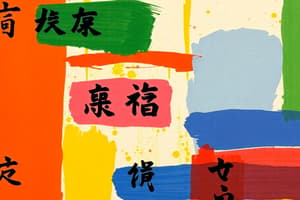Podcast
Questions and Answers
What is the focus of the book 'Japanese the Manga Way'?
What is the focus of the book 'Japanese the Manga Way'?
Japanese language structure
Who is the author of 'Japanese the Manga Way'?
Who is the author of 'Japanese the Manga Way'?
- Fredrik L. Schodt
- Furuya Mitsutoshi
- Wayne P. Lammers (correct)
- Hirokane Kenshi
Manga are Japanese comics and have been a popular publishing phenomenon only in recent years.
Manga are Japanese comics and have been a popular publishing phenomenon only in recent years.
False (B)
Japanese manga offer a unique way to learn the language by illustrating grammar points with examples from ____________.
Japanese manga offer a unique way to learn the language by illustrating grammar points with examples from ____________.
Match the following sentence structure elements with their descriptions:
Match the following sentence structure elements with their descriptions:
What was the original inspiration for launching a magazine featuring manga?
What was the original inspiration for launching a magazine featuring manga?
How are most Japanese books and magazines, including manga, opened and read?
How are most Japanese books and magazines, including manga, opened and read?
What is one of the key aspects of Japanese manga that makes them a great resource for language learners?
What is one of the key aspects of Japanese manga that makes them a great resource for language learners?
Manga panels are always arranged from left to right for English readers.
Manga panels are always arranged from left to right for English readers.
Manga primarily use conversational Japanese, making them ideal for learners who want to understand spoken language.
Manga primarily use conversational Japanese, making them ideal for learners who want to understand spoken language.
It's beneficial to spend time memorizing the hiragana character set in the Introduction before starting to ___________.
It's beneficial to spend time memorizing the hiragana character set in the Introduction before starting to ___________.
Why are manga considered a more logical next step for following up on textbook dialogues?
Why are manga considered a more logical next step for following up on textbook dialogues?
In manga, sentences grow longer and more convoluted in ________.
In manga, sentences grow longer and more convoluted in ________.
What is the purpose of reading the manga balloons in the same alphabet as English in 'Japanese the Manga Way'?
What is the purpose of reading the manga balloons in the same alphabet as English in 'Japanese the Manga Way'?
What is the system of romanization used in 'Japanese the Manga Way' to represent the Japanese language?
What is the system of romanization used in 'Japanese the Manga Way' to represent the Japanese language?
Learning Japanese script is not required for becoming fluent in Japanese according to the content.
Learning Japanese script is not required for becoming fluent in Japanese according to the content.
In Japanese, the alphabetic characters used in English are called ________.
In Japanese, the alphabetic characters used in English are called ________.
What is the vertical long mark usually called in katakana?
What is the vertical long mark usually called in katakana?
What is the comma for Japanese script represented as?
What is the comma for Japanese script represented as?
Japanese sentences with missing subjects are considered sentence fragments.
Japanese sentences with missing subjects are considered sentence fragments.
One of the best ways to learn to read kana and kanji is to practice writing them on ________.
One of the best ways to learn to read kana and kanji is to practice writing them on ________.
How are the Japanese vowels pronounced in romaji?
How are the Japanese vowels pronounced in romaji?
How should the word 'hate' be pronounced in romaji?
How should the word 'hate' be pronounced in romaji?
In romaji, long vowels are indicated by macrons over the vowels.
In romaji, long vowels are indicated by macrons over the vowels.
What is the Japanese word for 'persevere/work hard/give it one's all'?
What is the Japanese word for 'persevere/work hard/give it one's all'?
Which statement best describes the Japanese past tense compared to English past tense?
Which statement best describes the Japanese past tense compared to English past tense?
The Japanese term 'ka' is used to refer to a 'section' within a company.
The Japanese term 'ka' is used to refer to a 'section' within a company.
In Japanese, 'understand/comprehend' is equivalent to '__'.
In Japanese, 'understand/comprehend' is equivalent to '__'.
Match the following Japanese verbs with their negative polite forms:
Match the following Japanese verbs with their negative polite forms:
What does the negative form shirimasen deshita mean in Japanese?
What does the negative form shirimasen deshita mean in Japanese?
What does the suffix -cho mean in the job title 'henshikyoku-cho'?
What does the suffix -cho mean in the job title 'henshikyoku-cho'?
Ikimasho is the PL3 'let’s/I’ll ~' form of iku/ikimasu, which means '__'.
Ikimasho is the PL3 'let’s/I’ll ~' form of iku/ikimasu, which means '__'.
What does desho mean in Japanese?
What does desho mean in Japanese?
The -masho form of a Japanese verb expresses a guess.
The -masho form of a Japanese verb expresses a guess.
Flashcards are hidden until you start studying
Study Notes
Learning Japanese with Manga
- Japanese language has a reputation for being difficult, but the basic structure is actually quite simple.
- This book aims to prove the point by breaking down Japanese sentences into three basic types and illustrating them with manga examples.
The Benefits of Manga
- Manga can make the learning process more entertaining and establish points more clearly in the learner's mind by rooting them in real-life circumstances and usage.
- Manga is a perfect supplement to traditional language learning resources, offering a fun and engaging way to learn Japanese.
- Manga provides a natural and conversational way to learn Japanese, modeling the kind of language learners want to understand and speak.
Advantages over Prose Fiction
- Prose fiction can be a logical next step for following up on textbook dialogues, but it uses narrative passages to set the stage and move the action forward, making it slower-paced and less engaging.
- Manga, with its primarily conversational content, serves as a more logical next step for learners, providing a more dynamic and fun way to learn Japanese.
Benefits for Beginners
- Manga's lower-density text and fewer kanji characters make it less intimidating for beginners.
- Manga's illustrations serve as a visual aid, providing context and helping learners to understand the language more easily.
- Manga's format constantly reinforces the fact that every language act occurs in a specific social context, providing many details of that context at a glance.
Origins of the Book
- The book's concept is inspired by Mangajin, a magazine launched in 1990 that reprinting manga with a facing-page layout, providing a variety of helps for language learners.
- The book's format aims to provide a similar experience, using manga examples to illustrate Japanese language concepts and providing explanations and notes to facilitate learning.### Language Learning through Manga
- Using manga (Japanese comics) to learn Japanese language provides a unique opportunity to absorb cultural information and context.
- Manga offers a rich source of cultural information that cannot be replicated by traditional textbooks.
- Video materials such as films, TV programs, and anime provide both visual and audio components, which are essential for language learning.
The Origin of Japanese the Manga Way
- The book "Japanese the Manga Way" has its roots in Mangajin, a magazine that featured manga and articles on Japanese popular culture.
- The book's format is based on a series called "Basic Japanese," which provided systematic treatment of selected words and expressions.
- The book's purpose is to provide a systematic introduction to basic Japanese grammar and structure using authentic examples from real manga.
Who Can Benefit from this Book
- No prior knowledge of Japanese is necessary to learn from this book.
- The book serves as a "from scratch" primer for beginners and provides a comprehensive introduction to the language.
- The book can also be used by those who are already studying Japanese to consolidate and review their knowledge.
How to Use this Book
- Each lesson assumes the reader is familiar with the material covered in previous lessons.
- The book is best read in sequence, especially in the first half, to take advantage of the systematic sequential treatment.
- The modified Hepburn system of romanization is used to transcribe Japanese in the book.
- The standard four-line format for presenting balloon text includes transcription, romanization, word-for-word translation, and polished English translation.
Additional Tips
- Spend time memorizing the hiragana character set presented in the Introduction before starting the lessons.
- When trying to read everything in Japanese, look at the actual manga balloon as well as its transcription.
- Keep categorized lists or flashcards of the words you want to learn and try them out in sentences modeled on subsequent examples.### Japanese Language and Writing System
- The Japanese language can be learned through manga, which is a printed medium that contains spoken Japanese dialogue.
- To learn Japanese from manga, one needs to learn to read Japanese script, which is not necessary with the romaji (Roman letters) system used in this book.
- The book uses the modified Hepburn system, which is the most intuitive system for English speakers.
Pronunciation
- Vowels in Japanese have consistent pronunciations:
- a: like the "a" in "father" or "ha ha ha"
- i: like the "i" in "macaroni"
- u: like the "u" in "zulu"
- e: like the "e" in "get" or "extra"
- o: like the "o" in "solo"
- There are no "a" sounds like in "hat" or "hate", and "e" sounds are never silent at the end of words.
- Consonants are mostly pronounced as in English, except:
- ch: like the "ch" in "chin", not like "chorus" or "charade"
- fu: like blowing air out of the mouth, not like "fin" in English
- r: like a cross between English "r" and "l", made by lightly flicking the tongue against the ridge behind the upper teeth
Kana Guide
- Japanese writing system uses a syllabary, where each symbol represents a full syllable.
- Romaji syllabary uses vowels and consonants to form syllables.
- Hepburn romaji system uses macrons to indicate long vowels.
- Double-length vowels are written with a macron above the vowel.
- In kana, vowels can be elongated in different ways, depending on the word.
- Katakana is used to write foreign words and has the same sounds as hiragana.
Additional Tips
- When reading romaji, one needs to be consistent with vowel pronunciation and banish English vowel sounds.
- The book provides a detailed guide to pronunciation and kana for those who want to learn Japanese script.
Studying That Suits You
Use AI to generate personalized quizzes and flashcards to suit your learning preferences.




